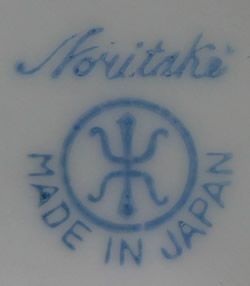
 |
 |
|
NOTES
Basemarks (Pottery marks)
When researching this topic where information is difficult to find I look for multiple sources. However, even this is frought with danger given the possibility that some of the sources have relied on other sources for their information. I have seen this form of repeated error in other areas of research for my collection. And who do you trust when two or more reliable sources have conflicting information?
I have multiple period wholesale and retail catalogues that hoppefully may eventually shed some light on this study.
Nippon, Japan, Made in Japan and Foreign
Early Japanese export pottery was marked with, Nippon, the Anglicised Japanese name for Japan.
The legislation of the USA in 1921 concerning the marking of imported items with their country of origin can be used to assist in the dating of Japanese export pottery throughout the world. This results from the obvious conclusion that the majority of manufacturers in Japan would not have gone to the trouble of having different polices for marking export items. However, given the cost of marking items, many items exist without any marks. Many countries continued to be happy with paper labels. This may also be the result of accidental omission.
Similarly, the use of "Foreign" or FOREIGN" on items imported onto the UK can be used to place an item within certain dates.
Colour
Contrary to many articles I have read I have found there is little or no correlation between the colour of the base marks on Japanese pottery and the date of manufacture. This is evidenced by many items where the base mark occurs in various colours. Also see below about the registration of logos in Japan. It is possible that potters registered the various colours to stop others from using similar base marks and then had to use the various colours themselves to preserve the registration.
Potters, factories and importers/exporters
I have listed some of the Japanese potters that I have been able to identify when researching the juicers on my website. It must be noted that a significant problem has arisen when reliable sources attribute some base marks to different factories. Perhaps some sources are confusing potters/factories with importers/exporters who often used their own distinctive basemark.
Registration of maker's marks (logos)
The registration of maker's marks in Japan were so specific including colour etc that it allowed for other companies to pirate a mark by doing as little as changing the colour. I am not sugsesting that all the different colours were used by totally different makers.
I have created a page to allow easy comparison of the variety of base marks and base mark colours used on juicers of the same form (same mould). See: Juicers_Japanese_basemark_variants.html
The table below lists potteries, factories and importers/exporters as determined by researching a wide range of books and internet sources.
The following listings are a work in progress, however, sufficient to demonstrate the point that I am making.
| Joan Ware |
| |
 |
|
|
|
|
|
| |
|
|
|
|
|
| Klimax |
| |
 |
 |
|
|
|
|
| |
|
|
|
|
|
| Manto Ware |
| |
 |
 |
|
|
|
|
| |
|
|
|
|
|
| Maple Ware |
| |
 |
|
|
|
|
|
| |
|
|
|
|
|
| Maruyama Toki |
| |
 |
|
|
|
|
|
| |
|
|
|
|
|
| Noritake |
| |
 |
 |
|
|
|
 |
| |
|
|
|
|
Possibly the mark used by an outsourced pottery |
| Rokko |
| |
 |
|
|
|
|
|
| |
|
|
|
|
|
| Takito Company |
I have located a listing in The pottery & glass salesman. v.26:1-5 AG(1922) indicating that TAIYO TRADING CO. INC was "Successor to Takito, Ogawa & Co. and Tajimi Co. Japanese China, etc. 101 5th Ave. The name, according to the current Takito website was "Taiyo Boeki" |
 |
 |
|
|
|
|
| |
|
|
|
|
|
Japanese pottery lustre hand painted maker's marks, base marks, backstamps on a juicer reamer squeezer



































